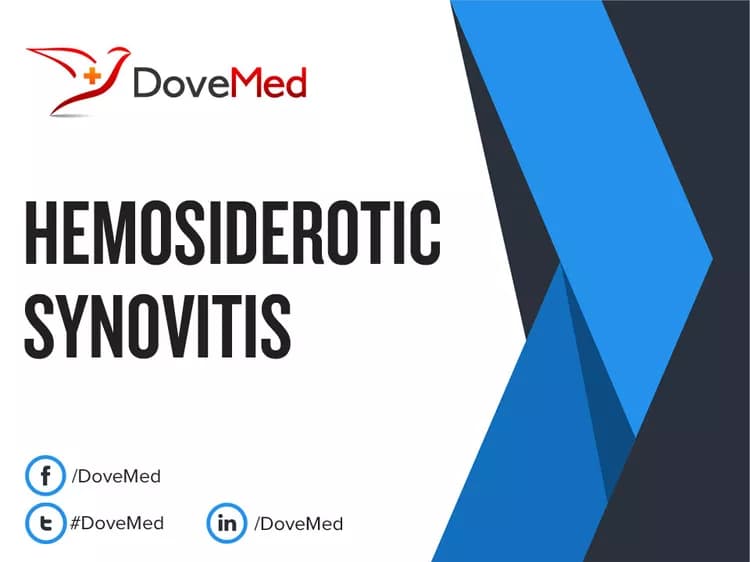What are the other Names for this Condition? (Also known as/Synonyms)
- Nonhemophilic Hemosiderotic Synovitis
What is Hemosiderotic Synovitis? (Definition/Background Information)
- Hemosiderotic Synovitis is inflammation of the synovium due to chronic bleeding into a joint space (also known as intra-articular hemorrhage). It is a rare and frequently long-standing condition. The synovium refers to the lubricating fluid found in the joints (knee, elbow)
- An individual (usually an adult male) may experience continuously recurring pain and inflammation at the joints, difficult joint movement and joint stiffness. Commonly the knees, elbows, and ankles are affected
- Sometimes, Hemosiderotic Synovitis may affect the joint severely causing walking difficulties, affecting daily life and routine activities. It can also lead to long-term complications such as osteoarthritis
- Mild Hemosiderotic Synovitis may be treated using conservative measures and medications, though severe cases may require surgical intervention. The prognosis of Hemosiderotic Synovitis is generally good with proper treatment, but this also depends upon the severity of the condition
Who gets Hemosiderotic Synovitis? (Age and Sex Distribution)
- Hemosiderotic Synovitis typically affects young adults in the 20-40 year age group. A male predominance has been observed
- There is no specific racial or ethnic preference observed and this joint disorder is seen worldwide
What are the Risk Factors for Hemosiderotic Synovitis? (Predisposing Factors)
The risk factors for Hemosiderotic Synovitis include the following:
- Hemophilia and other bleeding disorders
- Recurrent injury to the joints, which typically occurs in athletes and sportspersons
- Bleeding from synovial hemangioma (a benign vascular tumor of the synovium)
It is important to note that having a risk factor does not mean that one will get the condition. A risk factor increases ones chances of getting a condition compared to an individual without the risk factors. Some risk factors are more important than others.
Also, not having a risk factor does not mean that an individual will not get the condition. It is always important to discuss the effect of risk factors with your healthcare provider.
What are the Causes of Hemosiderotic Synovitis? (Etiology)
- The exact cause and mechanism of Hemosiderotic Synovitis occurrence is unknown
- When there is chronic bleeding into the synovial cavity at the joints, it results in inflammation of the joints
- This bleeding may be due to bleeding disorders, trauma to the joints, or benign tumors
What are the Signs and Symptoms of Hemosiderotic Synovitis?
Hemosiderotic Synovitis affects the joints and the signs and symptoms may include:
- Chronic bleeding into the joints causing joint pain (recurrent pain) and stiffness; swollen joints
- Restricted joint movements, difficulty moving the joints
- The commonly affected joints are the knees, elbows, and ankles
How is Hemosiderotic Synovitis Diagnosed?
A diagnosis of Hemosiderotic Synovitis is made using the following tools:
- Complete physical examination with evaluation of medical history
- X-ray, CT scan, or MRI scan of the affected joint
- Joint aspiration to analyze the synovial fluid
- Arthroscopic synovial tissue biopsy: A biopsy is performed and sent to a laboratory for a pathological examination. The pathologist examines the biopsy under a microscope. After putting together clinical findings, special studies on tissues (if needed) and with microscope findings, the pathologist arrives at a definitive diagnosis
- Analysis of joint fluid for crystals
Many clinical conditions may have similar signs and symptoms. Your healthcare provider may perform additional tests to rule out other clinical conditions to arrive at a definitive diagnosis.
What are the possible Complications of Hemosiderotic Synovitis?
Complications due to Hemosiderotic Synovitis could include:
- Severe joint pain: The mobility of the joints can be constrained, leading to difficulty in walking and performing normal daily activities. This can affect the quality of one’s life
- Recurrent hemorrhage can damage the joints irreversibly
- Secondary osteoarthritis: This joint disorder can cause osteoarthritis in the long run
- Damage of the knee, elbow, or other organs, vital nerves and blood vessels, during surgery
- Since Hemosiderotic Synovitis is a long-duration chronic and painful condition, it can cause severe emotional stress in the affected individuals
How is Hemosiderotic Synovitis Treated?
Treatment measures for Hemosiderotic Synovitis may include both conservative measures and surgical procedures, depending upon the severity of the condition:
- Avoid any physical activity that aggravates the joint condition further
- Applying ice to the joint can help reduce pain and swelling
- Non-steroidal anti-inflammatory drugs (NSAIDs): Certain medications can help reduce mild to moderate pain, within the affected joint
- Physical therapy may help restore strength, as well as improve flexibility of the joints and muscles
- Severe osteoarthritis may be treated with joint replacement therapy
- Post-operative care is important: A minimum activity level is to be ensured until the surgical wound heals
- Follow-up care with regular screening and check-ups are important
How can Hemosiderotic Synovitis be Prevented?
Current medical research has not established a way of preventing Hemosiderotic Synovitis occurrence. It is managed through medical support and surgical intervention techniques.
What is the Prognosis of Hemosiderotic Synovitis? (Outcomes/Resolutions)
- The prognosis of Hemosiderotic Synovitis is generally excellent when the condition is mild
- Severe cases with recurrent and repetitive bleeding into the damage can be treated through invasive procedures. However, the prognosis for chronic conditions is guarded
Additional and Relevant Useful Information for Hemosiderotic Synovitis:
The following DoveMed website link is a useful resource for additional information:
Related Articles
Test Your Knowledge
Asked by users
Related Centers
Related Specialties
Related Physicians
Related Procedures
Related Resources
Join DoveHubs
and connect with fellow professionals


0 Comments
Please log in to post a comment.